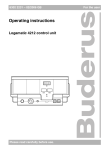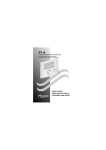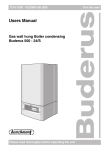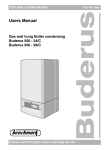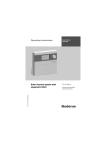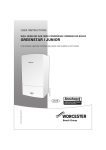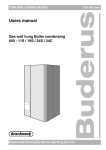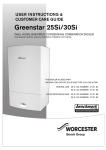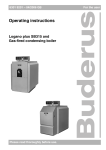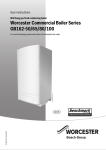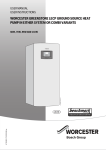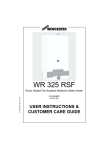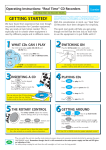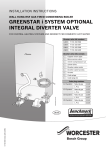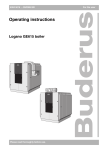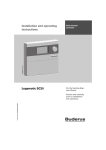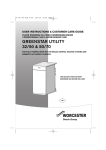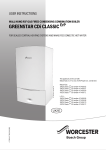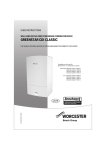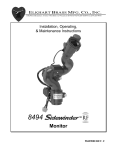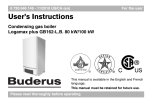Download TDS 300 user manual
Transcript
USER MANUAL SOLAR THERMAL SYSTEM CONTROLLER 6720613720 00.1 SD TDS 300 6 720 644 594 (2010/04) UK/IE CONTENTS CONTENTS 1 1.1 1.2 Safety instructions and explanation of symbols General safety instructions Symbols 3 3 3 2 2.1 2.2 Details of the product EU Declaration of Conformity Product description 5 5 5 3 3.1 3.2 3.3 3.4 Operation Elements of the solar pumping station controller controls View mode - viewing system settings Main menu 8 9 10 11 13 4 4.1 4.2 Faults Faults indicated on the display Faults not indicated on the display 14 14 16 5 5.1 5.2 5.3 5.4 5.5 Notes for the user Why is regular maintenance important? Important notes on heat transfer fluids Checking the solar thermal system Checking operating pressure, with possible re-adjustment Cleaning the collectors 18 18 18 18 19 19 6 User's log 20 2 6 720 644 594 (2010/04) SAFETY INSTRUCTIONS AND EXPLANATION OF SYMBOLS 1 SAFETY INSTRUCTIONS AND EXPLANATION OF SYMBOLS 1.1 GENERAL SAFETY INSTRUCTIONS ABOUT THIS MANUAL This manual contains important information about the safe and correct installation and operation of the solar thermal system. B Ask your heating engineer to provide you with all the technical documentation relating to the solar thermal system. B Read this manual carefully and keep it for future reference. B Always observe the safety instructions to prevent injury and damage to property. INTENDED USE The solar controller (referred to from now on as the controller) may only be used for operating solar thermal systems under the permissible ambient conditions (0 - 50 °C). The programmer must not be used outdoors, in damp rooms or in rooms where easily combustible gas mixtures could form. B Only operate the solar thermal system as intended and when the system is in proper working order. DOMESTIC HOT WATER TEMPERATURE The recommended DHW storage temperature is 60 °C. Where storage temperatures in excess of 60 °C may be achieved it is essential that the drawn hot water is controlled with a thermostatic blending valve. DISPOSAL B Dispose of packaging in an environmentally responsible manner. B When replacing components, dispose of the old parts in an environmentally responsible manner. 6 720 644 594 (2010/04) 3 SAFETY INSTRUCTIONS AND EXPLANATION OF SYMBOLS 1.2 SYMBOLS Safety instructions in this document are identified by a warning-triangle symbol and are printed on a grey background. Signal words indicate the seriousness of the hazard in terms of the consequences of not following the safety instructions. • Caution indicates that minor damage to property could result. • Warning indicates that minor personal injury or serious damage to property could result. • Danger indicates that serious personal injury could result. In particularly serious cases, lives could be at risk. Notes are identified by the symbol shown on the left. They are bordered by horizontal lines above and below the text. Notes contain important information in cases where there is no risk of personal injury or damage to property. 4 6 720 644 594 (2010/04) DETAILS OF THE PRODUCT 2 DETAILS OF THE PRODUCT 2.1 EU DECLARATION OF CONFORMITY The design and operation of this product conform to the applicable European directives and supplementary national requirements. Confirmity has been demonstrated. 2.2 PRODUCT DESCRIPTION DIAGRAM OF SOLAR THERMAL SYSTEM 4 1 2 3 7747006071.01-1.SD Fig. 1 1 2 3 4 System diagram Collector array Solar pumping station Solar cylinder Controller TDS 300 6 720 644 594 (2010/04) 5 DETAILS OF THE PRODUCT Main components of the solar thermal system Collector array • Consists of flat plate collectors or evacuated tube collectors Solar pumping station • Consists of the pump together with safety valves and shut-off valves for the solar thermal circuit Solar cylinder • Used for storing the collected solar energy • There are three different types: – Domestic hot water cylinder (indirect) – Thermal store (to back up a domestic heating system) – Combination cylinder (for domestic heating back-up and for domestic hot water) Controller TDS 300 • Includes two temperature sensors Tab. 1 OPERATING PRINCIPLE When the set temperature difference between the collector array (Æ Fig. 1, Item 1) and the solar storange cylinder (Æ Fig. 1, Item 3) is exceeded, the pump in the solar pumping station is switched on. The pump transports the heat transfer fluid through the collector array to the solar cylinder. There is a heat exchanger in the solar cylinder that transfers the free heat collected via the sun from the transfer medium to the water intended for washing or heating. 6 6 720 644 594 (2010/04) DETAILS OF THE PRODUCT CONTROLLER The controller is designed for use with a solar heating system. It can be mounted on a wall or is integrated in a solar thermal centre. In normal operating mode, the display screen (Æ Fig. 2) on the controller stays illuminated in green/ yellow for 5 minutes after the last button was pressed (activated by pressing the rotary selector ok , for example). The display shows the following: • Pump and valve status (as simple schematic diagram not representative of actual system) • System values (e.g. temperatures) • Selected functions • Fault messages 1 5 Fig. 2 Possible display indications 6 720 644 594 (2010/04) 7 OPERATION 3 OPERATION Your professional heating technician will set the solar thermal system when commissioning it, and it will run automatically. B Have your heating engineer explain to you how the solar thermal system works, and how to operate it. B Do not switch off the solar thermal system during long absences (e.g. when going on holiday). When installed according to the manufacturer's specifications, the solar heating system is intrinsically safe. B After a power failure or a long absence, check the operating pressure on the pressure gauge of the solar thermal system (Æ Section 5.4, page 19). WARNING: Risk of damage to system if programmer settings are changed. B Do not make any changes to any settings not described here. 8 6 720 644 594 (2010/04) OPERATION 3.1 ELEMENTS OF THE SOLAR PUMPING STATION The main components of the solar pumping station are: • Thermometers (Æ Fig. 3, Item 1 and 3): The built-in thermometers display the temperatures of the solar return (blue) and flow (red). • Pressure gauge (Æ Fig. 3, Item 2): the pressure gauge indicates the system pressure. The safety valve above it opens and releases the excess fluid pressure via the blow-off pipe if the system pressure rises above 6 bar. 1 2 3 7747004985.09-1.SD Fig. 3 1 2 3 Solar pumping station Display of temperature for solar return Pressure gauge and safety valve Display of temperature for solar flow 6 720 644 594 (2010/04) 9 OPERATION 3.2 CONTROLLER CONTROLS 1 2 5 8 1 2 3 4 5 6 7 8 7 7747006072-23.1 SD controller and display Display Rotary selector Back button Menu button Symbol for temperature sensor Displays of temperatures, hours of operation, etc. Valve symbol (black = open outlet) Active circulation diagram Control Rotary selector (can be turned and pressed) Menu button Symbol + ok Functions • Selecting system settings • Opens the main menu • Returns display to collector temperature - menu Back button Tab. 2 SWITCHING OFF THE SYSTEM B Disconnect the programmer from the mains power supply by means of the isolating device (e.g. mains plug). 10 6 1 5 3 4 Fig. 4 1 6 720 644 594 (2010/04) OPERATION 3.3 VIEW MODE - VIEWING SYSTEM SETTINGS + You can use the rotary selector to view the following system data if the relevant components are installed and the supplementary functions have been activated by your heating engineer. Display 1 5 Supplementary function System data None • Temperature (°C) • Hours of operation, cumulative (h) • Hours of operation, today (h/d) • Pump speed (%) • Pump and valve status • Flow temperature (°C) • Return temperature (°C) • Heat usage, cumulative (kWh) • Heat usage, today (kWh/d) • Flow temperature (°C) • Hours of operation, cumulative (h) • Hours of operation, today (h/d) Heat meter 5 7 8 Heat exchanger antiicing system 5 4 Other functions Cooling function Tab. 3 Other functions Shows other active functions. Possible indications (display flashes when function is active): • Evacuated tube collector • S. Europe function • Thermal disinfection • Cooling function Overview of system data 6 720 644 594 (2010/04) 11 OPERATION Status display Cylinder maximum temperature max. min. 4 1 5 The cylinder maximum temperature is displayed if the set limit is exceeded. Collector minimum temperature The collector minimum temperature is displayed if the temperature drops below the set limit. max. 1 5 Collector maximum temperature The collector maximum temperature is displayed if the set limit is exceeded. Tab. 4 12 Status indications 6 720 644 594 (2010/04) OPERATION 3.4 MAIN MENU The Main menu can be used to set the maximum temperatures for the heat consumers (solar cylinder, cylinder C, swimming pool). Once the cylinder or swimming pool reaches the maximum temperature, charging of that heat consumer is stopped. If no entry is made for more than 60 seconds, the programmer exits the main menu. WARNING: Risk of scalding if maximum cylinder temperature is set to more than 60 °C and hot water thermostatic mixer is not fitted or set too high. B Only set the maximum temperature of the solar cylinder to higher than 60 °C if a builtin thermostatic hot water mixer limits the outlet temperature to 60 °C. If the domestic water supply is very hard, the maximum temperature of the solar cylinder should not be set higher than 60 °C. B Press the menu button to switch to the Main menu. Main menu Maximum solar cylinder temp. 60°C B Turn the rotary selector + - to select the energy consumer B To change the maximum temperature, press the rotary selector flashing). B To change the setting, turn the rotary selector + - B To save the new setting, press the rotary selector B To exit the Main menu, press the Back button Setting range Default setting 10 - 95 °C 60 °C 6 720 644 594 (2010/04) ok (temperature starts . . ok . New setting 13 FAULTS 4 FAULTS 4.1 FAULTS INDICATED ON THE DISPLAY When indicating a fault, the display is back-lit in red. In addition, the type of fault is indicated by symbols. The individual fault messages can be retrieved using the rotary selector (by turning it). Fault messages continue to be displayed until the fault is rectified. B If a fault occurs, contact a qualified heating engineer. Indication / Type of fault Effect Possible causes Remedy Temperature sensor not/ incorrectly connected. Contact your heating engineer. Temperature sensor or sensor lead defective. Contact your heating engineer. Sensor failure S1 ...S8 Associated components (pumps/valves) are switched off. Sensor short circuit S1 ...S8 Associated components (pumps/valves) are switched off. Temperature sensor or sensor lead defective. Contact your heating engineer. “No fluid flow in solar systems”/“secondary system” The temperature difference between collector temperature sensor and bottom cylinder temperature sensor or between heat exchanger flow temperature sensor and bottom cylinder temperature sensor is too great. Air in the system. Contact your heating engineer. Pump is stalled. Contact your heating engineer. Valves or shut-offs are closed. Contact your heating engineer. Pipe clogged. Contact your heating engineer. “Therm. disinfection running time error” The thermal disinfection has not been carried out. Tab. 5 14 Target temperature not reached. Contact your heating engineer. Possible faults indicated on the display 6 720 644 594 (2010/04) FAULTS Indication / Type of fault Effect Possible causes Remedy Collector connections reversed. Contact your heating engineer. “Collector connections reversed” The collector temperature drops 15 K within 10 seconds of switching on. “Gravity fed circulation (at night) ”(Expert menu > Settings) The cut-in temperature differential for pump SP is reached between 22:00 and 06:00. Tab. 5 Gravity-feed restrictor opened manually or defective. Contact your heating engineer. Possible faults indicated on the display 6 720 644 594 (2010/04) 15 FAULTS 4.2 FAULTS NOT INDICATED ON THE DISPLAY Type of fault Effect Possible causes Remedy Pump not running even though conditions for switching on are met. The solar storage cylinder is not being supplied by the solar thermal system. No power supply; fuse or power cable faulty. Contact a qualified electrician. The temperature at the bottom of the cylinder is close to, or above the set maximum cylinder temperature. When the temperature drops 3 K below the maximum cylinder temperature, the pump switches on. The collector temperature is close to, or above the set maximum collector temperature. When the temperature drops 5 K below the maximum collector temperature, the pump switches on. There is no electrical power lead to the pump or it is not connected. Contact your heating engineer. Cooling function active. – The controller checks which cylinder can be charged (only in systems with two cylinders) – Pump is faulty. Contact your heating engineer. The system animation on the display is running and the pump is “humming”. The solar storage cylinder is not being supplied by the solar thermal system. The pump is stalled due to a mechanical blockage. Contact your heating engineer. Temperature sensor is displaying an incorrect figure. Pump is being activated/ deactivated too early/too late. Tab. 6 16 Temperature sensor incorrectly fitted. Incorrect temperature sensor fitted. Contact your heating engineer. Possible faults not indicated on the display 6 720 644 594 (2010/04) FAULTS Type of fault Effect Possible causes Remedy Domestic hot water is too hot. Risk of scalding Cylinder temperature limit and hot water mixing valve are set too high. Set the cylinder temperature limit lower, inform engineer if necessary. Domestic hot water too cold (or domestic hot water flow volume too low). Domestic hot water temperature is set too low on boiler control, on heating programmer or on hot water mixing valve. Tab. 6 Contact your heating engineer. Possible faults not indicated on the display 6 720 644 594 (2010/04) 17 NOTES FOR THE USER 5 NOTES FOR THE USER 5.1 WHY IS REGULAR MAINTENANCE IMPORTANT? Your solar domestic hot water system or domestic hot water and space heating system is virtually maintenance free. However, we recommend that you have your system serviced at least every 2 years by your heating engineer. In that way you can ensure smooth and efficient operation and early detection and elimination of any possible damage. 5.2 IMPORTANT NOTES ON HEAT TRANSFER FLUIDS WARNING: Risk of injury from contact with heat transfer fluid (water and propylene glycol mixture). B If heat transfer fluid comes into contact with eyes: hold eyelids wide open and thoroughly rinse eyes with running water. B Keep heat transfer fluid out of reach of children. The heat transfer fluid is biodegradable. Your engineer has been instructed to ensure, when commissioning the solar thermal system, that the heat transfer fluid provides protection against freezing at temperatures down to at least – 30 °C. 5.3 CHECKING THE SOLAR THERMAL SYSTEM You can contribute to the smooth functioning of your solar thermal system by doing the following: • Checking the temperature difference between flow and return and between the collector and cylinder twice a year, • Checking the operating pressure for solar thermal stations • Checking the heat quantity (if a calorimeter has been installed) and/or the operating hours. Enter the values in the log on page 20 (which may also be copied). The completed log can help qualified technicians when checking your solar thermal system and performing maintenance. 18 6 720 644 594 (2010/04) NOTES FOR THE USER 5.4 CHECKING OPERATING PRESSURE, WITH POSSIBLE RE-ADJUSTMENT Pressure fluctuations in the solar thermal circuit due to temperature changes are normal and do not lead to faults in the solar thermal system. B Check the system pressure on the pressure gauge (Æ Fig. 3) when the system is cold (about 20 °C). IF PRESSURE DROPS A pressure drop can be caused by the following: • There is a leak in the solar thermal circuit. • An automatic air vent has expelled air or vapour. If the pressure of the solar thermal system has dropped: B Check whether heat transfer fluid has collected in the storage vessel under the solar pumping station. B Call in a qualified heating engineer if the system pressure drops 0.5 bar below the level recorded in the commissioning log (Æ Installation and servicing instructions for the solar station). 5.5 CLEANING THE COLLECTORS DANGER: Risk of death by falling from roof B Inspection, maintenance and cleaning work on the roof must only be carried out by qualified technicians. Due to the self-cleaning effect when rain falls, the collectors do not usually need cleaning. 6 720 644 594 (2010/04) 19 20 Tab. 8 Date Log for solar thermal system values (can be copied) Cylinder System pressure bottom (°C) in bar Collector (°C) Solar flow (red) Solar return in °C (blue) in °C Pressure gauge on solar pumping station Solar pumping station: Direction facing: Temperatures displayed on controller Roof pitch: Cylinder type: Thermometers on solar pumping station Collector type: Number of collectors: Tab. 7 Date commissioned: USER'S LOG System operator: 6 Operating hours in h and/or heat quantity in kWh Weather conditions 1=clear sky 2=partly cloudy 3=very cloudy 4=overcast USER'S LOG 6 720 644 594 (2010/04) NOTES 6 720 644 594 (2010/04) 21 NOTES 22 6 720 644 594 (2010/04) NOTES 6 720 644 594 (2010/04) 23 WORCESTER, BOSCH GROUP: TECHNICAL SUPPORT: 0844 892 4010 APPOINTMENTS: SPARES: LITERATURE: 6 720 644 594 01905 752571 0844 892 9800 TRAINING: 01905 752526 SALES: 01905 752640 WEBSITE: Worcester, Bosch Group Cotswold Way, Warndon, Worcester WR4 9SW. Tel. 0844 892 9900 Worcester, Bosch Group is a brand name of Bosch Thermotechnology Ltd. worcester-bosch.co.uk 0844 892 3000 worcester-bosch.co.uk
























